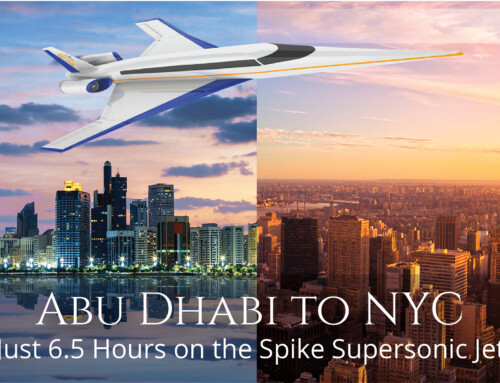
Bringing back supersonic flight is one of aviation’s most exciting frontiers — not just because of the speed, but because of what it unlocks: faster global commerce, stronger international collaboration, and the shrinking of distances that divide us. Of course, big leaps don’t come easy. From certification rules to sonic booms, the challenges are real — but solvable. Here’s how the next generation of innovators is approaching them.
1. Sonic Boom and Overland Flight Restrictions
The sharp, thunderclap-like sonic boom of the Concorde contributed to the ban on supersonic flight over land in most countries. Without solving this, supersonic travel would be limited to transoceanic routes.
How we are addressing this concern: Advances in low-boom aerodynamic shaping and computational fluid dynamics (CFD) are helping reduce perceived boom levels to below 75 decibels — quieter than a passing truck. This opens the door not just to faster Atlantic crossings, but also to supersonic routes across the U.S., Europe, and Asia.
2. Maximizing Fuel Efficiency
At supersonic speeds, drag increases exponentially — which means fuel burn can easily spiral out of control, undermining economic and environmental goals.
How we are addressing this concern: By designing slender, aerodynamically optimized fuselages, employing high-lift airfoils, and using lightweight composite structures, aircraft can achieve better lift-to-drag ratios. Every improvement here directly translates into greater range, lower fuel consumption, and more competitive operating costs.
3. Subsonic vs. Supersonic Flight Control
Supersonic aircraft must perform safely and smoothly during takeoff, climb, cruise, descent, and landing — each with different aerodynamic demands. Maintaining control across these regimes is complex.
How we are addressing this concern: Advanced fly-by-wire systems and smart control surfaces help tailor responsiveness across speed ranges. Blended configuration designs reduce instability, allowing safer transitions between subsonic and supersonic phases of flight without sacrificing performance.
4. Engine Performance Across Mach Regimes
A supersonic jet’s engine must produce strong thrust at low speeds, manage intake compression at Mach 1+, and do so without excessive noise or fuel consumption.
How we are addressing this concern: Variable-geometry inlets, advanced turbofans, and bypass-ratio tuning are being used to optimize efficiency across the flight envelope. New designs avoid afterburners entirely — a major step toward quieter and more efficient operations.
5. Noise and Emissions Compliance
Today’s regulations on noise and emissions are far stricter than in the Concorde era. Jets must meet ICAO Chapter 14 and FAA Stage 5 noise standards to operate commercially.
How we are addressing this concern: Improved nacelle acoustics, lean-burn combustors, and nozzle shaping reduce both takeoff and landing noise. Meanwhile, emissions targets are addressed through cleaner burn profiles and engine thermal optimization. Meeting these standards is not just a legal requirement — it’s a business imperative.
6. Environmental Impact: GHGs, NOx, and Contrails
Flying faster and higher introduces new environmental considerations. Emissions at high altitude have amplified effects, especially in the form of greenhouse gases, NOx, and contrail-induced cirrus clouds.
How we are addressing this concern: By optimizing cruise altitude and engine thermodynamics, NOx emissions can be minimized. Improved flight planning and fuel selection also reduce contrail formation. Ongoing atmospheric research will help operators refine flight paths to mitigate warming effects.
7. SAF Availability vs Demand
Sustainable Aviation Fuel (SAF) offers lower lifecycle emissions, but global supply remains limited — especially as subsonic aviation begins scaling up its demand.
How we are addressing this concern: Supersonic developers are designing aircraft that can run on 100% SAF and working with fuel producers to secure long-term supply agreements. By aligning with national and international SAF initiatives, demand from the supersonic sector can help stimulate broader production.
8. Flight Testing Requirements
Supersonic flight testing is more complex than for subsonic jets. Specialized airspace, instrumentation, and safety protocols are essential — and expensive.
How we are addressing this concern: Developers are using advanced simulation tools and digital twins to reduce reliance on physical testing. Incremental test programs — starting with low-speed and expanding into supersonic — make for a safer, more cost-effective process. Strategic partnerships with military and civil test ranges help overcome airspace limitations.
9. FAA and EASA Certification Standards
There is currently no established civil certification framework specific to supersonic aircraft. Existing regulations were written with subsonic transports in mind.
How we are addressing this concern: Industry is actively working with regulators to develop Special Conditions and eventually new rulebooks tailored to supersonic designs. By proving safety equivalence and maintaining open, data-driven dialogue with the FAA and EASA, we’re creating a path toward responsible certification.
10. Global Regulatory Harmonization
Even if an aircraft is certified in one country, international operations require regulatory alignment across jurisdictions. Differing noise, emissions, and operating policies add layers of complexity.
How we are addressing this concern: Early coordination with ICAO, bilateral safety agreements, and pre-certification outreach to global regulators helps ensure smoother market entry. Supersonic operators are also advocating for global standards on boom, noise, and routing to unify the rules of the sky.
11. Capital Requirements and Long Development Cycles
Bringing a supersonic jet to market can cost upwards of $2–3 billion and take 7–10 years — a daunting prospect for startups and even major OEMs.
How we are addressing this concern: A phased development plan, government-backed grants (such as SBIR and NASA partnerships), and dual-use commercial/military applications help de-risk the process. With strategic capital, focused milestones, and the right partners, long-cycle aerospace development becomes achievable — and even investable.
12. Industry and Public Skepticism
Supersonic flight is still viewed by some as a luxury gimmick or environmental burden. Convincing stakeholders this time is different requires more than optimism.
How we are addressing this concern: Credibility is built through execution. By sharing progress transparently, demonstrating clear use cases (like time-critical business travel), and proving environmental stewardship, developers can shift perception from skepticism to enthusiasm.
Final Thoughts
Yes, the road to supersonic flight is challenging — but not because it’s impossible. It’s challenging because it’s worth doing right. Each of these hurdles represents an opportunity for smart engineering, responsible policy, and visionary thinking.
Supersonic flight has the potential to transform travel, business, diplomacy, and how we experience the world. In the coming weeks, we’ll dive deeper into these challenges — and the bold solutions under development to overcome them.





